Hearty Dutch Oven Beef Stew: A Classic, Comforting One-Pot Meal
There’s nothing quite like a steaming bowl of homemade beef stew to bring warmth and comfort, especially during the colder months. Our Hearty Dutch Oven Beef Stew recipe is designed to be incredibly easy, budget-friendly, and a perfect one-pot meal for busy weeknights or cozy weekends. Imagine succulent, fork-tender beef simmered slowly in a rich, deeply flavored sauce, infused with aromatic vegetables and a hint of red wine. This isn’t just a meal; it’s an experience that nourishes both body and soul.
This stew is the epitome of comfort food: thick, incredibly rich, and unbelievably delicious. Its robust flavors develop beautifully as it gently simmers, transforming simple ingredients into a gourmet-like dish that your entire family will adore. Forget bland, watery stews; this recipe delivers a hearty, satisfying texture and an explosion of savory goodness in every spoonful. When the temperatures drop, this stew becomes a welcome centerpiece at any dinner table.
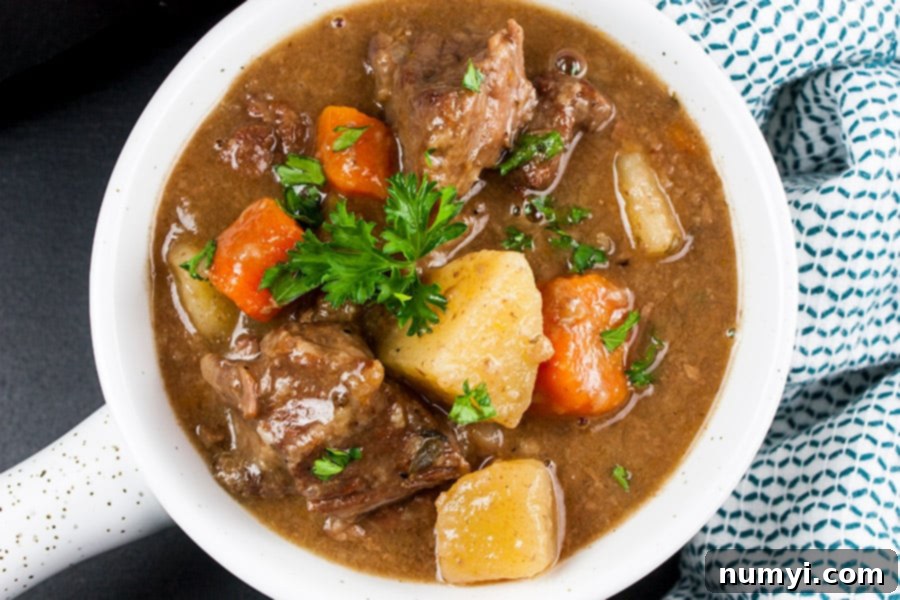
Why This Hearty Beef Stew Will Become Your Go-To Recipe
This thick, flavorful beef stew is more than just simple to prepare; it’s a culinary masterpiece that delivers on taste, convenience, and coziness. Here’s why you’ll undoubtedly fall in love with this recipe:
- Unrivaled Comfort: It’s the ultimate comfort food, perfect for chilly evenings or when you need a meal that feels like a warm hug. The slow cooking process tenderizes the beef to perfection, and the rich, savory broth creates a truly satisfying experience.
- Effortless Preparation: While it boasts complex flavors, the actual hands-on cooking time is minimal. Most of the magic happens as the stew simmers, allowing you to go about your day while dinner practically makes itself.
- Budget-Friendly: Utilizing economical cuts of beef like chuck roast and readily available vegetables, this recipe provides a substantial and nourishing meal without breaking the bank. It’s smart cooking that doesn’t compromise on quality or flavor.
- Family Favorite: This classic beef stew is a guaranteed crowd-pleaser. Its hearty nature and familiar flavors appeal to everyone, making it a staple in family meal rotations.
- Fantastic Leftovers: Like many great stews, this one tastes even better the next day! The flavors deepen and meld overnight, making the leftovers ideal for quick, delicious lunches or another easy dinner.
- One-Pot Wonder: Minimizing cleanup is always a win. Preparing this entire dish in a single Dutch oven means fewer dishes and more time to enjoy your delicious creation.
- Deep, Rich Flavor Profile: The combination of searing the beef, deglazing with red wine, and a medley of herbs creates an incredibly complex and satisfying flavor that will keep you coming back for more.
Some of our other favorite soup and stew recipes to make include Thick and Hearty Homestyle Chili, Slow Cooker Chicken and Wild Rice Soup, Creamy Chicken Stew, Creamy Tomato Basil Soup, and Creamy White Chicken Chili. But for classic, savory comfort, this Dutch Oven Beef Stew stands in a league of its own.
Essential Ingredients for a Perfect Beef Stew
Crafting the ultimate hearty beef stew requires a selection of fresh, quality ingredients. Each component plays a vital role in building the layers of flavor and achieving that desirable thick, comforting consistency. Here’s a closer look at what you’ll need and why each item is important:
- Chuck Roast – Or beef stew meat. Chuck roast is hands down the perfect cut of beef for slow cooking stews. Its generous marbling and connective tissue break down beautifully during extended simmering, resulting in incredibly tender, melt-in-your-mouth beef. If using pre-cut “stew meat,” ensure it’s from the chuck or round for best results.
- Salt and Black Pepper – These fundamental seasonings are crucial for bringing out the natural flavors of the meat and vegetables. Don’t skimp on seasoning the beef before searing; it forms the foundational layer of taste. Freshly ground black pepper adds a superior aromatic quality.
- Vegetables – The classic trio for stew provides both flavor and texture.
- Carrots: Add natural sweetness and a vibrant color, balancing the savory notes.
- Celery: Contributes a subtle, earthy, aromatic base that complements the other ingredients.
- Onion: Forms the aromatic backbone of the stew, caramelizing to add depth and sweetness.
- Garlic Cloves: Essential for a pungent, savory kick that elevates all the other flavors. Use fresh garlic for the best impact.
- Potatoes: Russet or Yukon Gold potatoes are ideal, as they hold their shape well while still contributing to the stew’s hearty thickness. They absorb the rich broth and provide a satisfying, starchy element.
- Vegetable Oil – or canola oil. A neutral-flavored oil with a high smoke point is necessary for properly searing the beef, creating that crucial browned crust without burning.
- All-Purpose Flour – This is key for creating a roux, which thickens the stew and gives it a luxurious, velvety texture. It also helps to absorb some of the rich fat from the beef, creating a cohesive sauce.
- Flavorful Spices for Beef Stew – These herbs and spices are the secret to a truly scrumptious and aromatic stew!
- Dried Thyme: Earthy, minty, and slightly floral, thyme is a classic pairing with beef.
- Bay Leaves: Add a subtle, herbaceous backdrop, imparting a gentle bitterness that balances the richness. Remember to remove them before serving.
- Dried Oregano: Offers a warm, slightly peppery, and robust Mediterranean note.
- Tomato Paste: A powerhouse of umami, tomato paste concentrates tomato flavor, adding richness, depth, and a slight tanginess that brightens the stew.
- Red Wine and Beef Broth – This combination creates the incredibly rich and complex liquid base for the stew.
- Red Wine: A dry red wine like Cabernet Sauvignon or Merlot is highly recommended. It adds a sophisticated depth of flavor, cuts through the richness of the beef, and is essential for deglazing the pan. The alcohol cooks off, leaving only its wonderful flavor.
- Beef Broth: Choose a high-quality, low-sodium beef broth or stock to control the saltiness and ensure a rich, savory base. If you don’t want to use the wine, simply substitute it with an additional cup of beef stock, though you will miss out on some of the profound depth the wine provides.
How to Craft the Perfect Hearty Beef Stew in Your Dutch Oven
Follow these detailed steps to create a truly unforgettable hearty beef stew:

Don’t Sweat The Recipe is supported by its readers. We may earn a commission if you purchase through a link on our site. Learn more.
First things first, gather and prepare all your beef stew ingredients. This means cubing your chuck roast, dicing your onion, mincing your garlic, and chopping your carrots, celery, and potatoes into roughly 1-inch pieces. This “mise en place” (everything in its place) will make the cooking process much smoother and more enjoyable.
On medium-high heat, add the vegetable oil to a large Dutch oven or a large, heavy-bottomed pot (one that has a tight-fitting lid). A Dutch oven is ideal because it distributes heat evenly and retains it well, which is crucial for slow simmering.
Once the oil is hot and begins to smoke slightly, it’s time to brown the beef. Add the seasoned beef (tossed with salt and pepper) to the pot, but do it in batches. It’s crucial not to overcrowd the pan, as this will steam the meat instead of searing it, preventing that beautiful, flavorful crust from forming. Brown each batch very well on all sides until deep golden brown. This searing step is vital for developing rich flavor in your stew – it’s where the magic of the Maillard reaction happens. Once browned, remove the beef with a slotted spoon and set it aside, leaving any delicious browned bits at the bottom of the pot.
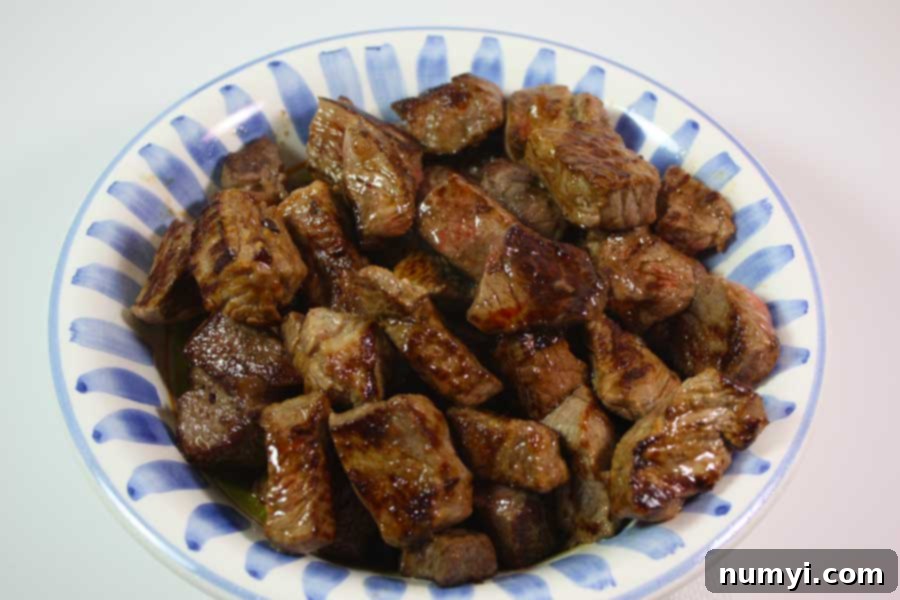
Next, add the diced onions to the same pot, using the leftover oil and browned bits, and sauté them for about 5 minutes over medium heat until they have softened and become translucent. Make sure to stir occasionally to prevent burning.
Reduce the heat to medium-low, then sprinkle in the flour. Cook the flour for 2 minutes, stirring constantly. This step creates a roux, which will serve as the thickening agent for your stew and cook out the raw flour taste.
Add the minced garlic to the pot and cook for just 1 minute more, stirring continuously. Be careful not to burn the garlic, as it can turn bitter very quickly.
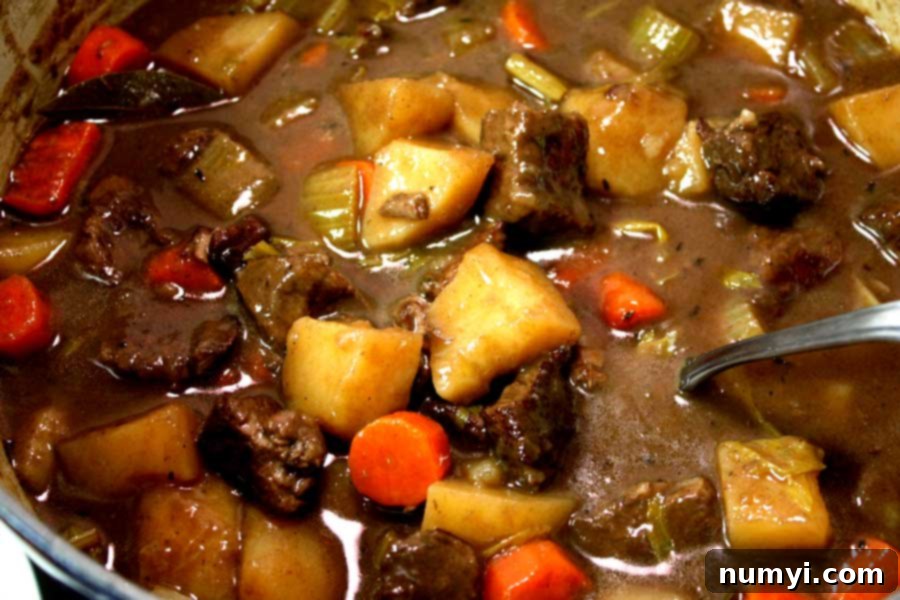
Pour in the red wine and immediately deglaze the pan. Use a wooden spoon or spatula to vigorously scrape up any savory brown bits (fond) stuck to the bottom of the pot. These bits are packed with flavor and are essential for a rich stew. As the wine heats and comes to a simmer, the flour will begin to thicken it, creating a luscious base.
If you’re hesitant about cooking with wine or prefer not to, you can substitute it with an equal amount (1 cup) of additional beef broth. However, I truly don’t recommend skipping the wine. A dry red wine like Cabernet Sauvignon or Merlot adds such a remarkable depth of flavor and complexity to this beef stew that you wouldn’t want to miss out on that nuance. The alcohol cooks off during simmering, leaving behind only its delicious essence.
Allow the wine to simmer for 5 minutes to reduce slightly and deepen its flavor. Then, return the browned beef to the pot and add the beef broth, bay leaves, dried thyme, dried oregano, and a tablespoon of tomato paste. Stir everything together until well combined.
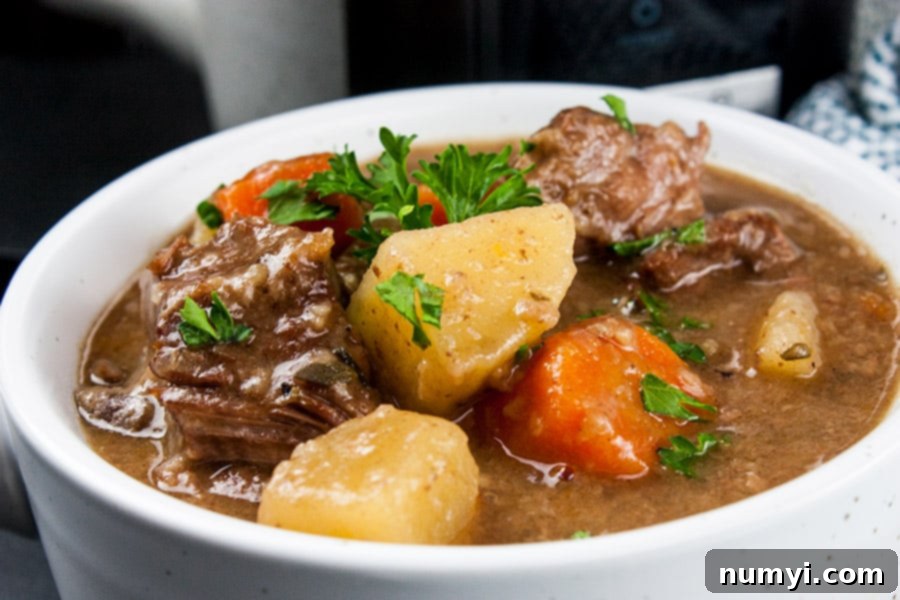
We are not going to bring this to a rolling boil. Instead, bring it back to a gentle simmer, cover the Dutch oven with its tight-fitting lid, and cook on very low heat for about 1 hour. This initial simmering period allows the beef to start tenderizing and the flavors to begin melding beautifully.
After 1 hour, add the potatoes, carrots, and celery to the pot. Stir them gently into the stew, ensuring they are mostly submerged in the liquid. Continue to simmer the stew, covered, for another 30 minutes, or until both the beef and the vegetables are perfectly tender. Stir occasionally to prevent anything from sticking to the bottom. During this final phase, taste the stew and adjust the seasoning with more salt and pepper if needed.
Once everything is tender and the flavors are robust, turn off the heat and let the stew sit, covered, for 15 minutes before serving. This resting period allows the flavors to further meld and the sauce to thicken slightly, resulting in an even more satisfying consistency.
Serve this magnificent stew hot, perhaps with your favorite crusty bread for soaking up every last drop of the rich sauce. It also pairs wonderfully with mashed potatoes, rice, or egg noodles. My family absolutely adores this deep, rich-flavored stew! It truly is comfort food at its finest, a classic that never disappoints.
Pro Tips for an Unforgettable Beef Stew
- Don’t Rush the Sear: The browning of the beef is arguably the most crucial step for flavor. Take your time, work in batches, and ensure a deep, dark crust forms on each piece. Those browned bits (fond) in the bottom of the pan are flavor gold!
- Quality Ingredients Matter: While a budget-friendly meal, using good quality beef broth and a decent bottle of dry red wine (one you’d enjoy drinking) will significantly elevate the final taste of your stew.
- Taste and Adjust: Always taste your stew before serving. Seasoning can vary based on your broth and personal preference. Don’t be afraid to add more salt, pepper, or a pinch of herbs to perfect the flavor profile.
- Evenly Cut Vegetables: Cutting your vegetables to a consistent size ensures they cook evenly. For this stew, 1-inch chunks are ideal.
- Resting is Key: The 15-minute rest period after cooking allows the stew to settle, the flavors to deepen, and the sauce to achieve its optimal thickness. Patience here is rewarded!
Frequently Asked Questions About Beef Stew
Absolutely! Searing the meat is a non-negotiable step for a truly flavorful beef stew. This process creates a beautiful brown crust on the exterior of the beef through the Maillard reaction, which locks in savory flavors. It also leaves behind highly flavorful browned bits (fond) at the bottom of the pan, which are essential for deglazing and building the stew’s rich base. Skipping this step results in a less flavorful and visually appealing stew.
From beginning to end, this hearty beef stew recipe takes approximately 2 hours to cook. This includes about 30 minutes for prep work (chopping, searing), and then 1.5 hours of simmering time on the stovetop. This slow simmering ensures the chuck roast becomes wonderfully tender and the flavors have ample time to develop and meld together, creating a truly delicious and comforting meal.
To enhance the flavor of your beef stew, focus on these key techniques:
Sear the meat thoroughly – Generously season the beef with salt and pepper before searing it in batches. Achieving a deep brown crust creates a concentrated savory flavor and leaves behind flavorful fond.
Deglazing the pan – After searing, deglazing the pan with red wine (or beef broth) allows you to scrape up all those delicious browned bits from the bottom, incorporating them into your stew’s liquid base for incredible depth.
Slow cooking – A slow, gentle cooking method is crucial. It tenderizes tougher cuts of meat like chuck roast and allows all the spices and ingredients to infuse into the broth, developing a complex and harmonious flavor profile.
Use quality broth – A good quality beef broth or stock makes a significant difference. Consider a homemade stock if possible.
Tomato Paste – Don’t underestimate the power of tomato paste for adding rich umami flavor.
Once your hearty beef stew has completely cooled, transfer it to an airtight container. It can be safely stored in the refrigerator for up to 4 days. To reheat, simply warm portions gently in the microwave or slowly on the stovetop over medium heat, stirring occasionally, until heated through. Add a splash of extra beef broth if it seems too thick after refrigeration.
Yes, beef stew freezes very well! Allow the completely cooled beef stew to reach room temperature, then transfer it to freezer-safe airtight containers or heavy-duty freezer bags. It can be stored in the freezer for up to 3 months. When ready to enjoy, thaw overnight in the refrigerator, then reheat gently on the stovetop or in the microwave. Just keep in mind that potatoes can sometimes change in texture after freezing and thawing, becoming slightly softer or more mealy, but the overall flavor of the stew will remain excellent.
For beef stew, starchy or all-purpose potatoes like Russet, Yukon Gold, or red potatoes are excellent choices. Russets tend to break down slightly, helping to thicken the stew, while Yukon Golds offer a creamier texture and hold their shape a bit better. Avoid waxy potatoes if you prefer a thicker stew, as they don’t release as much starch.
If your stew is too thin, you have a few options: you can either let it simmer uncovered for a bit longer to reduce the liquid, or create a slurry. To make a slurry, mix 1-2 tablespoons of cornstarch with an equal amount of cold water until smooth. Stir this mixture into the simmering stew and cook for a few more minutes until it reaches your desired thickness. Another option is to mash some of the cooked potatoes against the side of the pot to release their starch.
Absolutely! This recipe adapts beautifully to a slow cooker. Follow the searing and deglazing steps on the stovetop first (don’t skip these for flavor!). Then, transfer the browned beef, sautéed onions/garlic, deglazed liquid, and all other ingredients (except potatoes, carrots, and celery) to your slow cooker. Cook on low for 6-8 hours or on high for 3-4 hours. Add the potatoes, carrots, and celery during the last 1.5-2 hours of cooking to ensure they are tender but not mushy.
More Delicious Soup & Stew Recipes to Explore
Homemade Chicken And Dumplings
Beef Barley Soup
Root Vegetable Soup
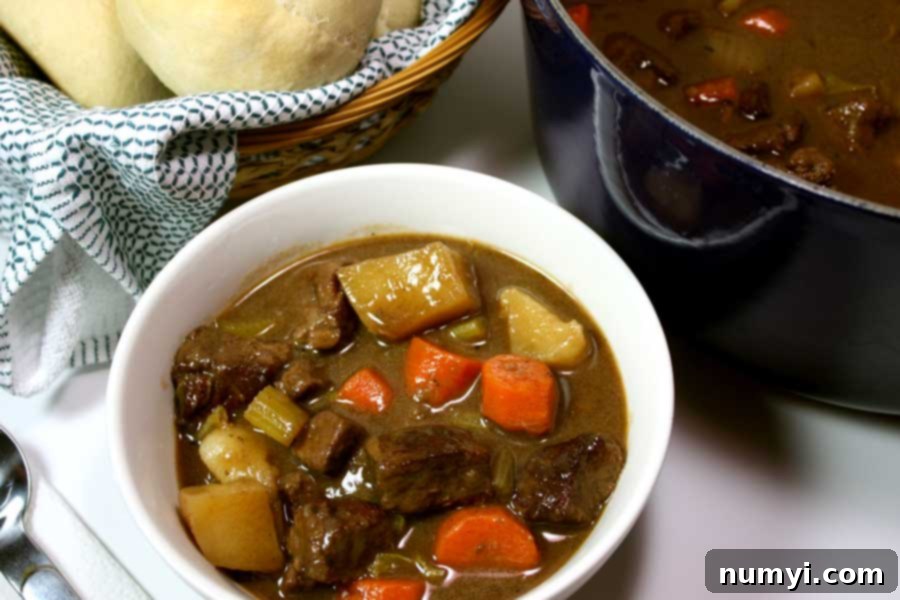
Dutch Oven Thick & Hearty Beef Stew Recipe
Print
Pin
Rate
Ingredients
- 2 lbs boneless chuck roast, cut into 2-inch pieces
- 3 tablespoons Vegetable oil
- 2 teaspoons Salt
- 1/2 teaspoon freshly ground Pepper, more to taste
- 1 large Onion, cut into 1-inch chunks
- 1/4 cup All-Purpose Flour
- 2 cloves Garlic, minced
- 1 cup Dry Red Wine (like Cabernet or Merlot, or extra beef broth)
- 4 cups Beef broth
- 1/2 teaspoon dried Thyme
- 2 Bay leaves
- 1/2 teaspoon dried Oregano
- 1 tablespoon Tomato paste
- 4 medium Carrots, peeled and cut into 1-inch pieces
- 3 stalks Celery, including tops/leaves, cut into 1-inch pieces
- 3 large Russet Potatoes, peeled, cut into 1-inch pieces
Instructions
-
On medium-high heat, add the vegetable oil to a Dutch oven or large heavy pot (one that has a tight-fitting lid). Ensure the oil is hot before adding beef.
-
When the oil begins to smoke slightly, add the beef (seasoned with salt and pepper) and brown very well in batches. Do not overcrowd the pan, as this prevents proper searing. Once browned, remove the beef with a slotted spoon and set aside.
-
Add the diced onions to the same pot and sauté for about 5 minutes, stirring occasionally, until they are softened and translucent.
-
Reduce the heat to medium-low, then sprinkle in the flour. Cook for 2 minutes, stirring often, to create a roux and cook out the raw flour taste.
-
Add the minced garlic and cook for 1 minute, stirring continuously to prevent burning.
-
Pour in the red wine and deglaze the pan, using a wooden spoon to scrape up any brown bits stuck to the bottom. The flour will start to thicken the wine as it comes to a simmer. (If not using wine, substitute with 1 cup of beef broth).
-
Simmer the wine for 5 minutes, allowing it to reduce slightly. Then, add the beef broth, bay leaves, dried thyme, dried oregano, tomato paste, and the browned beef back into the pot. Stir well to combine.
-
Bring the stew back to a gentle simmer (do not boil vigorously). Cover the pot and cook on very low heat for about 1 hour.
-
After 1 hour, add the potatoes, carrots, and celery to the stew. Stir gently, cover, and continue to simmer for another 30 minutes, or until the meat and all vegetables are tender. Taste the stew and adjust seasoning with additional salt and pepper as needed.
-
Turn off the heat and let the stew sit, covered, for 15 minutes before serving. This allows the flavors to deepen and the sauce to thicken perfectly. Serve hot with your favorite crusty bread or side.
Nutrition
Adapted from about.com
